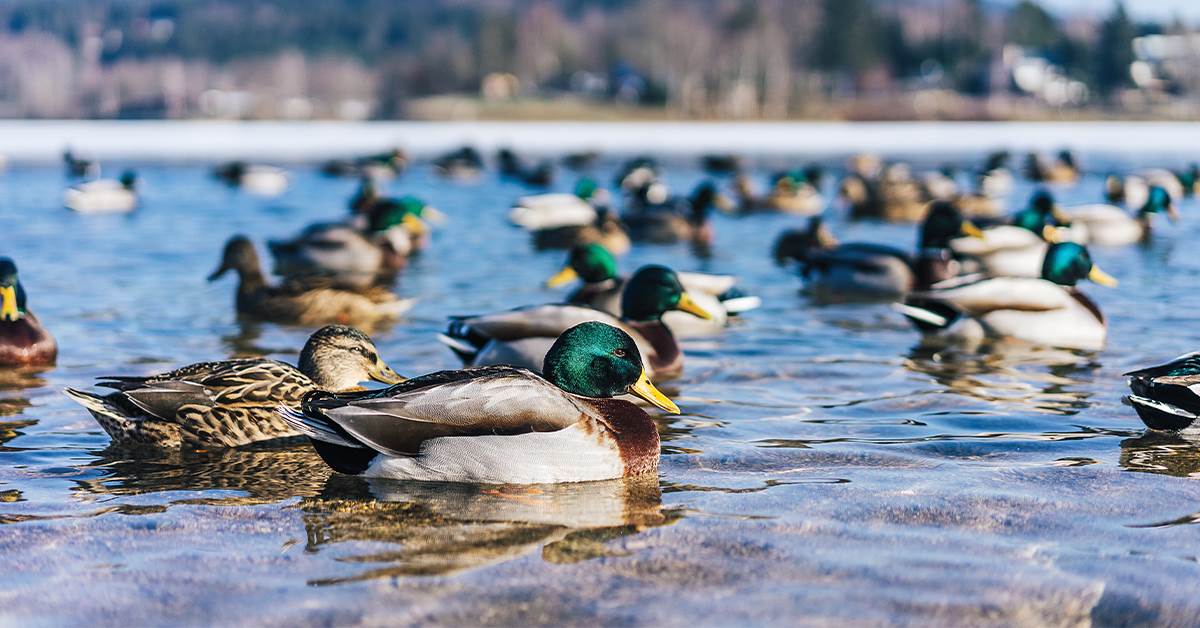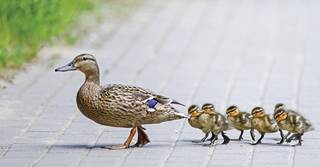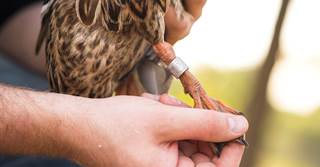Understanding Waterfowl: The Adventures of Urban Mallards
Researchers have made some surprising discoveries about the behavior of birds raised in cities and suburbs
Researchers have made some surprising discoveries about the behavior of birds raised in cities and suburbs

By Ben O'Neal, PhD
Hunters and other conservationists clearly understand the importance of natural wetlands such as prairie potholes to the health of waterfowl populations. In recent years, however, thousands of new bodies of water have been created on the margins of growing cities and suburbs across the United States. Unlike the wetlands that were scoured thousands of years ago by massive sheets of ice, these detention basins and neighborhood ponds have been artificially created in very short periods of time. Many of these ponds are constructed to manage runoff from hard surfaces, while others are designed for aesthetic value. In regions with growing human populations, the densities of these ponds can be impressive. As these developed landscapes continue to multiply and grow, researchers and wildlife managers are studying the role they play in the ecology and harvest of mallards and other waterfowl.
Although some urban areas have long been known to support an abundance of mallards, these landscapes are not generally included in annual waterfowl breeding population surveys that guide harvest regulations. Without scientific counts, it's difficult to estimate how many mallards are supported by urban habitats. To explore that question, researchers with Franklin College in Indiana are conducting systematic waterfowl surveys in urban areas and mapping the number and acreage of man-made water bodies in parts of the Midwest. Initial analyses indicate that the abundance of suburban ponds and the number of mallards that are raised in these areas may warrant closer attention from the waterfowl management community.

Photo SHUTTERSTOCK.COM
Moreover, the researchers are examining the extent to which urban mallards move outside their "core landscapes." Answering that question will help managers understand the birds' availability to hunters and how urban mallards interact with other segments of the mallard population. Since 2016, researchers have captured and banded mallards each summer in urban and suburban counties of Indiana and Illinois. These metropolitan trap sites differ significantly from the marshes of North Dakota and the rice farms of Arkansas. They can include neighborhood and apartment ponds, commercial properties, urban streams, wastewater treatment plants, and city parks. Researchers focus their trapping efforts during the midsummer months so they can capture and band birds on the landscapes where they nest and raise their young. The birds' age and sex are recorded at the time of banding, which allows researchers to investigate behaviors associated with these demographic factors. This requires extra care in summer, when young mallards have yet to develop their distinctive plumages and mature drakes in eclipse plumage can be mistaken for females.
Following the summer banding season, researchers wait patiently as hunters begin the important work of citizen science by reporting the recovery of banded birds to the US Geological Survey's Bird Banding Laboratory. Like clockwork, band returns accrue throughout the hunting season and begin to tell a story about marked samples of birds. In the case of urban mallards banded in Indiana and Illinois, approximately 12 percent have been reported by hunters. Given that only about 80 percent of all harvested banded birds are reported, the researchers estimate that approximately 14 percent of urban mallards from their sample area are harvested each year. Thus, urban mallards not only find their way into hunters' bags but also appear there at rates comparable to the broader midcontinent mallard population.
But what prompts these urban mallards to leave the security of the city limits? While it is widely assumed that the birds leave urban areas only when harsh winter weather forces them to, banding results suggest otherwise. More than half of banded urban mallards were harvested in October and November, well before ice-up. Not surprisingly, a little over half these birds were harvested locally (within six miles of the banding location). However, about a quarter of banded mallards were harvested over a broader area (10 to 60 miles) and about 14 percent at distances greater than 60 miles.
Over recent decades, biologists have learned that the movements of ducks are far more complex than we once thought, and the movements of urban mallards are no exception. Band recovery analysis has revealed that urban mallards disperse in every direction from banding locations. In fact, a map of their movements looks like a sunburst.

Photo Ryan Askern
Among the banded mallards that traveled long distances, 86 percent were drakes. And where did these roving greenheads go? Some 71 percent of them were recovered to the north of their banding sites. One urban mallard banded in east-central Illinois reached Wollaston Lake, Saskatchewan, 1,400 miles away. What might prompt an urban Midwestern mallard to fly hundreds of miles north to the Dakotas or Prairie Canada? Researchers can't say for sure, but one likely possibility is that urban drakes pair with hens passing through during the spring migration and then follow them to their breeding grounds. A second possibility is that drakes engage in molt migrations to northern locations during the late summer months. Whether it's pair bonding or a molt migration, the genes and physiology needed for such vigorous movements still persist in many urban mallards despite their origins.
It is becoming increasingly clear that urban areas do offer habitat for significant numbers of mallards and that these birds contribute to annual waterfowl harvests. As such, researchers and managers are investigating new ways to monitor and model urban segments of the mallard population. A collaborative team in the Great Lakes region is launching a multiyear study that will investigate breeding success and survival among urban mallards as well as the birds' fine-scale movements and their genetic composition relative to other population segments. This work is likely to grow in significance as urban development expands across much of the United States. Land-cover projections from the US Forest Service predict a two-fold increase in urban landscapes over the next 20 years.
In addition to the increasing role urban mallards may play in waterfowl harvests, these highly recognizable birds can also help our neighbors who do not hunt appreciate waterfowl in tangible ways. Demographic models suggest that almost 90 percent of Americans will live in urban and suburban communities by 2050. While we work to conserve wild places, we shouldn't ignore the valuable role that populated landscapes can play in conservation and hunting. Given the likability of ducks and the willingness of some species to live among people, "municipal mallards" may serve as important ambassadors for wetlands and wildlife conservation by helping the public connect with nature, even within the confines of our own communities.
Dr. Ben O'Neal is associate professor of biology at Franklin College in Franklin, Indiana. He and his students are currently studying applied ecology questions related to urban mallards and Canada geese, nesting marsh birds, and wetland restoration.
Ducks Unlimited uses cookies to enhance your browsing experience, optimize site functionality, analyze traffic, and deliver personalized advertising through third parties. By continuing to use this site, you agree to our use of cookies. View Privacy Policy